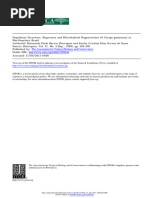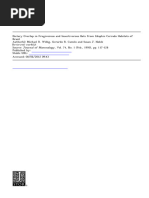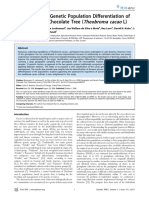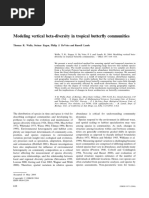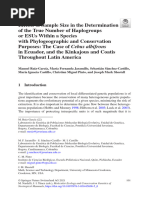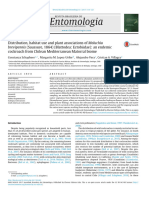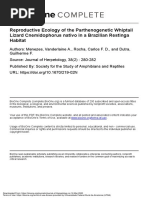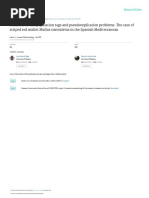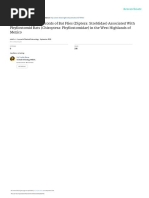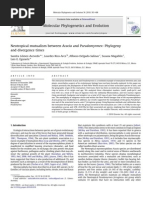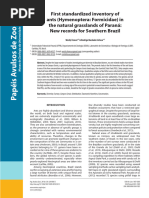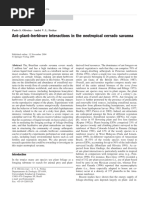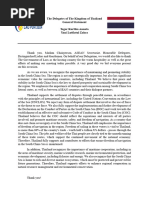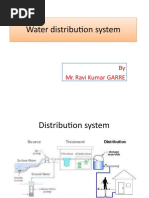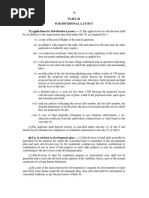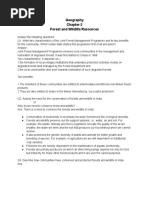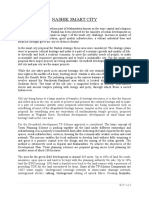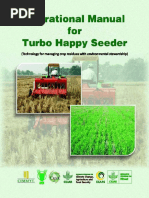majer1994
majer1994
Uploaded by
gatodaprataCopyright:
Available Formats
majer1994
majer1994
Uploaded by
gatodaprataCopyright
Available Formats
Share this document
Did you find this document useful?
Is this content inappropriate?
Copyright:
Available Formats
majer1994
majer1994
Uploaded by
gatodaprataCopyright:
Available Formats
Arboreal Ant Community Patterns in Brazilian Cocoa Farms
Author(s): Jonathan D. Majer, Jacques H. C. Delabie and Martha R. B. Smith
Source: Biotropica, Vol. 26, No. 1 (Mar., 1994), pp. 73-83
Published by: The Association for Tropical Biology and Conservation
Stable URL: http://www.jstor.org/stable/2389112 .
Accessed: 27/11/2013 07:01
Your use of the JSTOR archive indicates your acceptance of the Terms & Conditions of Use, available at .
http://www.jstor.org/page/info/about/policies/terms.jsp
.
JSTOR is a not-for-profit service that helps scholars, researchers, and students discover, use, and build upon a wide range of
content in a trusted digital archive. We use information technology and tools to increase productivity and facilitate new forms
of scholarship. For more information about JSTOR, please contact support@jstor.org.
The Association for Tropical Biology and Conservation is collaborating with JSTOR to digitize, preserve and
extend access to Biotropica.
http://www.jstor.org
This content downloaded from 128.206.9.138 on Wed, 27 Nov 2013 07:01:34 AM
All use subject to JSTOR Terms and Conditions
BIOTROPICA 26(1): 73-83 1994
Patternsin BrazilianCocoa Farms1
ArborealAntCommunity
Jonathan D. Majer
School of Environmental of Technology,Bentley,WesternAustralia6102.
Biology,CurtinUniversity
Jacques H. C. Delabie and Martha R. B. Smith
Divisionof Zoology, CEPLAC, 45.600, Itabuna, Bahia, Brazil
ABSTRACT
The distributionof arboreal-foraging at the CentreforCocoa Researchin Bahia,
antson cocoa treeswas investigated
betweenant specieswerequantifiedusingdata on the presenceor absenceof ant specieson
Brazil.The interactions
1100 cocoa trees.The distributionof ants was also mapped in four30 x 40 m plots of cocoa, and the species
richnessand biomassofantswas assessedby chemicalknockdownsfromwithintheterritories of fiveofthedominant
ant species.
Ninety-onespeciesof ant wereencountered, of whichsevenreacheddominantstatus.A quantitativeevaluation
of the numberof positiveand negativeassociationsbetweeneach ant speciesconfirmed the statusof mostof these
dominantsand also indicatedthata further10 speciesmayhavesub-dominant status.The dominantsweredistributed
cocoa plot,gaps in the mosaicwerefew.Some
in a mosaic-likefashionand, exceptin an old, non-pesticide-treated
of the dominantants influencedthe numberof associatedant species,the lengthof thoseant specieswith which
theywereable to co-exist,and also the speciescompositionof antswithintheirterritory.
Keywords: ants; biomass;Brazil; distribution; mosaic.
dominance;Formicidae;
diversity;
REPORTS OF ARBOREAL-FORAGING ANTS BEING the tropicshas recentlybeen reviewedby Majer
DISTRIBUTED in a three-dimensional mosaic come (1993).
fromthetropicalpartsof Africa,e.g.,in Ghanaian Whilst workingat the CentreforCocoa Re-
cocoa (Majer 1972); Asia, e.g.,in SolomonIslands search(CEPLAC) in Bahia, Brazil,Leston(1978)
coconut(Greenslade1971); Australia,e.g.,in Man- mapped an ant mosaicin Atlanticrainforest.This
go (Majer & Camer-Pesci1991); and SouthAmer- comprised sevenantspecieswhichLestonconsidered
ica, e.g., in rainforest(Leston 1978). This mosaic as dominant,withan additionalspeciesconsidered
comprises a limitednumberofdominantants,which to be sub-dominant.Leston(1978) also observed,
have been definedas thosespecieswhichpredom- but did not map, an ant mosaic in nearbycocoa
inate numerically, which tend to have mutually whichcontainedfiveadditionaldominantspecies.
exclusivedistribution patterns,and whichtendto Winder(1978) mapped theoccurrence of ant spe-
occupylargeand continuousexpansesof forestor cies on cocoa flowersat CEPLAC and noteda mo-
treecrop canopy(Leston 1973). Associatedwith saic-likedistribution patternof variousantgenera.
thismosaicare sub-dominantants,whichare also His data did notindicatewhetheranyof theseants
numerousbutwhichdo notusuallyholdlargetracts weredominantor not.
of canopy,and non-dominants, whichoccurwithin In thispaper we providemoredetailedinfor-
or betweentheterritories ofdominantants.In view mationon thenatureof theantmosaicin Brazilian
ofthefactthatcertainsub-dominant and non-dom- cocoa. More specifically, we proposea quantitative
inantantstendto be associatedwithparticular dom- methodforidentifying whichspeciesaredominant,
inantant species(Room 1971), thereis a tendency and we investigate how thesedominantspeciesare
formuch of the ant communityto be distributed distributed and how theyaffect theotherantspecies
in a mosaic-likefashion.Areaswheredominantants whichoccurwithintheirterritory. This information
are absentfromthetreesare referred to as gaps, or is importantas it documentsthe capacityof this
lacunae, and such areas tend to be relativelyre- dominant groupofanimals(Fittkau& Klinge1973)
stricted.The composition ofantmosaicsthroughout to influencethe compositionof the associatedant
community. It also providesinformation whichmay
be utilisedin theeffort to screenant speciesforuse
in biologicalcontrolprogramsfortropicaltreecrop
pests.This aspectof the currentstudyis reported
I Received27 May 1993, accepted7 August 1993. on elsewhere(Majer & Delabie, in press).
73
This content downloaded from 128.206.9.138 on Wed, 27 Nov 2013 07:01:34 AM
All use subject to JSTOR Terms and Conditions
74 Majer, Delabie, and Smith
METHODS down sampling,we finallyobtainedsamplesfrom
fivetreeswith Azteca instabilis,10 with Azteca
FIELD WORK.-Fieldwork was carried outwithinthe chartifex spiriti,13 withCrematogaster erecta,nine
groundsof the Centrefor Cocoa Research(CE- withEctatommatuberculatum, and six with Was-
PLAC), Itabuna, Bahia, (14?45'S, 39?13'W) and manniaauropunctata. Knockdownsamplingofcan-
formedcomponents of severalresearchmodulesdi- opy invertebrates was subsequently performed be-
rectedat elucidatingthe possible use of ants in tween16 Octoberand 1 November1989. The day
biologicalpest controlprograms.The resultsare priorto sampling,the undergrowth beneatheach
presentedin a sequencewhichenables an under- treewas clearedwitha machette.A 4 m x 4 m
standingof the ant mosaicto be developedrather calicosheetwas thenplacedbeneatheachtree,which
thanas a time-sequence of data collection. was thensprayedwitha 3 litermixtureof delta-
In orderto determinewhethertherewas any methrin dilutedto a concentrationof0.2 5 g liter-
-'.
associationbetweenthe variousspeciesof ants,we After30 minutes, thecanopywasshakentodislodge
surveyedthespeciespresenton 1100 randomlyse- animals,and the sheetswereremovedto the lab-
lectedtreesspreadthroughout theCEPLAC grounds. oratorywherethe invertebrates werecollectedand
SamplesweretakenbetweenAugust1990 andJune sortedto ordinalor,in thecase ofants,specieslevel.
1991 by manuallycollectingants fromtreesfora The ants and remaininginvertebrates were then
5 minuteperiod followedby the beatingof the separately drainedfor12 hrin filter paperfunnels.
canopyover a 2 x 2 m sheet.Care was takento The resulting weightof thesampleswas considered
selecttreeswhichwereat least 15 m apartin order to approximatethe live weightof the animals.All
to ensureindependence of samples. collectedant materialwas sortedand identified to
Four30 m x 40 m plotsofcocoa wereselected specieslevel. In some instancesit was not possible
formappingofarborealants.The plotswerelocated to obtainspecific namesso a CEPLAC antreference
in the centreof blocksof cocoa and werethusfree collectioncode numberwas allocatedto theappro-
of edge-effects.Plots 1, 2, and 3 were beneath priatespecies.A fullreference is deposited
collection
plantedErythrina shadetreesand wererespectively in the Myrmicology Laboratoryat CEPLAC.
of 19, 18, and 8 yearold cocoa whichhad been
regularlysprayedwithcarbarylor trichlorphon to DATA ANALYSIS.-We experiencedsome difficulty
minimizeinsectpest problems.Plot 4, containing distinguishing dominantorsub-dominant antsfrom
60 yearold cocoa, differed fromthe restin thatit thosespecieswhichwere non-dominant. Our de-
had not been treatedwith pesticidefor over 20 cisionswereinitiallybased on threesubjectivecri-
years,and cocoa had been plantedunderpartially teria,not all of whichpertainedto each speciesof
clearedsemi-deciduous rainforest.The positionof ant.Firstly, thosespecieswheremorethan100 ants
the cocoa and shade treeswas firstmapped. Each wereobservedforagingon treeswereconsideredto
treewas theninspectedfora periodof 5 minutes be dominant.Secondly,thosespecieswhichoccu-
and representativesof all ant specieson the trunk pied extensivecontiguousblocks of treesin the
and foliageorwithincavitieswerecollected.During absenceof othersuch specieswerealso classifiedas
thisperioda 2 m x 2 m calico sheetwas placed dominant.A thirdcriterion fordominancewas the
underthe treeand the ants were dislodgedfrom presenceof a relativelyhigh biomass of ants on
the upper canopy by beatingwith a long pole. trees.
Mappingof antson Plots 1-4 was completedbe- Since a givenspeciesdid not alwayssatisfyall
tween13 and 29 September1989. threecriteriafordominance,we consideredthata
On completionof mapping,the dominantant moreobjectivemeansforidentifying dominancewas
species in the entireblock in which Plot 3 was needed. The followingquantitativemeans forde-
situatedweremapped between4, 5 October1989 tectingdominancein the ant fauna was therefore
(at thisstagein the investigation we classifiedant devised.The frequency on treesof each ant species
speciesas dominantusingthesubjective criteria
out- surveyedin the 1100-treesurveywas firstcalcu-
lined in the Data Analysissection).The resulting lated.Then,usingonlythosespecieswhichoccurred
map was used to selecttreesforsamplingby the on > 5 percentof the trees(71 species),the asso-
chemicalknockdownprocedure.We had intended ciationbetweenspecieson treeswas testedby x2
tosample10 treesoccupiedbyeachoffivedominant analysiswithYates' correction applied.This is iden-
ant speciespresentin thisblock. However,due to ticalto theprocedureused byRoom (1971) forthe
changesin thedistribution of dominantantsin the measurement ofassociationbetweenantsin Ghana-
2-3 week intervalbetweenmappingand knock- ian cocoa. The numberof timeseach speciesre-
This content downloaded from 128.206.9.138 on Wed, 27 Nov 2013 07:01:34 AM
All use subject to JSTOR Terms and Conditions
ArborealAnts 75
spectively (P < 0.05) positive
exhibiteda significant latum,tendedto monopolizelargecontiguous blocks
ornegativeassociationwithanotherspecieswas then of canopy.Finally,in termsof high biomass,the
totalledand an Index of Dominance was cal- Aztecaspp. and Crematogaster spp. all satisfiedthe
culatedas follows: dominancecriteria,due to the presenceof large
numbersof small ants, and E. tuberculatum also
P
Index of Dominance(ID) = N P satisfiedthiscriterion because the low densitiesof
antswereoffsetby thelargesize of theworkers.
whereN is thenumberofnegativeassociations and Figure 1 shows the relationshipbetweenthe
P is the numberof positiveassociations.The ra- Index of Dominance and theoverallnumberof
tionalebehindthisindexis thata dominantspecies statistically significant positiveand negativeinter-
should exhibita greaternumberof negativeasso- actionsrecordedforeach species.Althoughsome-
ciationswithotherspecies,both dominantor oth- what arbitrary, the diagrammay be divided into
erwise,whilsttheremaining speciesare morelikely threezones:ID < -0.8; ID > -0.8 but < + 0.8;
to co-existwith otherspeciesas a resultof their and ID > +0.8. The fivespecieswhose ID was
lowerdensities,less aggressivebehaviour,and the > + 0.8, namelyA. chartifex spiriti,A. instabilis,
oftheirsharingthesame habitatrequire- Cr. limata,E. tuberculatum
possibility and W. auropunctata,
ments.We do notconsiderthealternative outcome were all specieswhichhad alreadybeen classified
of a non-dominant exhibitingsignificant negative as dominantby the threesubjectivecriteriamen-
withseveraldominantantsto be likely tioned above (the dominantsCr. erectaand Cr.
associations
becausesucha specieswould inevitably be uncom- acuta werenotfoundduringthe 1100-treesurvey).
mon and henceunlikelyto exhibitstatistically sig- Furthermore, the56 specieswithID values <-0.8
nificantnegativeassociations. In orderto investigate wereall specieswhich,on thebasisofthesubjective
theinfluence of dominantantson otherantspecies, criteria,would all be regardedas non-dominant
we calculatedthemeannumberofantspeciesfound species.A further 10 speciesoccurredin themiddle
witheach dominantspeciesin thechemicalknock- ID range.These weregenerallyspecieswhichex-
downsamples.The numberofassociatedantspecies hibitedmoderatedensityvaluesbut whichdid not
werethencomparedbyone-wayanalysisofvariance. monopolizelargetractsof canopy.Theydid, how-
An inventory of all ant specieswhichoccupied ever,exhibita numberofnegativeassociations with
each treewithintheterritories of thedominantant otherspecies,and we regardthis group as sub-
species,whichweremappedin Plots 1-4, was then dominantspecies.
preparedand the lengthsof each specieswas mea- Figures2 and 3, respectively, showthepositive
sured.The overallpercentageof ant species(total and negativeassociationsbetweenthe ant species
= 91) which fellwithineach mm size-classwas used in the aforementioned analysis.The diagrams
then calculated.This calculation was then repeated show associations which are significant at the 5
separatelyforthosespecieswhichoccurredwithin percentand 10 percentlevels,respectively, by solid
the territoryof each dominantspecieswhose dis- and dottedlines,and the speciesconsideredto be
tributionhad been mapped. The observeddistri- dominantor sub-dominantare respectively shown
bution of ants by size range was then compared by boxed or in boldface. The dominant ants exhibit at
x2 analysiswiththeexpectedsize rangehad theco- leastonenegativeassociation withanotherdominant
existingants been randomlydrawnfromthe total ant.Furthermore, the 10 sub-dominant antsshown
pool of ants. In orderto produce 'expected'cell in Figure 1 also exhibitnegativeassociationswith
valuesgreaterthan5, we bulkedthe 2-3 mm, 4- at leastone dominantant.Withjusttwoexceptions
6 mm and 7-11 mm size classes. (Crematogaster sp. prox. limata withParatrechina
sp. 124, Camponotus abdominaliswithCamponotus
crassus),negativeassociationsbetweensub-domi-
RESULTS nant ants were not found.With the exceptionof
DOMINANCESTATUSOF ANTS.-Our threesubjective the associationbetweenE. tuberculatum and Phei-
criteriafor recognizingdominanceenabled us to dole sp. 103, thereare no significant positiveas-
provisionallyidentify sevenspeciesofdominantant. sociationsbetweendominantand otherant species.
Aztecachartifex spiriti,A. instabilis,CrematogasterThereare,however,manypositiveassociationsbe-
limata,Cr. erecta,Cr. acuta, and W. auropunctata tweensub-dominants and non-dominants and be-
wereall foundin numbersgreaterthan 100 during tweencertainpairs of sub-dominantspecies.The
the 5 minuteobservation periods.All of theabove, overallresultof thisis forgroupingsof non-dom-
exceptCr.erectabutwiththeadditionofE. tubercu- inantantsto occurin associationwithcertainsub-
This content downloaded from 128.206.9.138 on Wed, 27 Nov 2013 07:01:34 AM
All use subject to JSTOR Terms and Conditions
76 Majer, Delabie, and Smith
1.2 -
1.0 A.instabilis E.tuberculatum
08 Wauropuctata
El Cr.limata Dominants
0 Wauopnc-taA.chartifex spiriti
c 0.6
~~ 0.4 ~~ Ca.cingulatus
o 0.2 Solenopsis sp.47 C
la
0.0 sp.103
El ~~~Pheidole
0 02 Ca.abdominalis M.floricola Sub-dominants
sp.124
x El ~~~~~~~~~~~~~Paratrechina
-0.4 Cr. prox.limata
~~~~~~~~El
X Cr.curvispinosa
la
c -0.6 W.rochai El El Ca.crassus
-0.8 2
-1.0 sp El 7 SPP. sp Non-dominants
17 4
-1.2 a spp.,I I spp.I
0 2 4 6 8 10
No. of interactions
FIGURE 1. Relationshipbetweenthe numberof significant positiveplus negativeassociationsbetweenant species
and the Indexof Dominance(ID) of each species,The horizontallinesarbitrarily
delimitthe non-dominantant (ID
< -0.8), the sub-dominantant (ID > -0.8 but < +0.8) and the dominantant species(ID > +0.8). The full
genericnamesare given in Figures2 and 3.
dominantspecies(e.g., Camponotus cingulatus,Ca. tributedthroughout theplot,oftenon treeswhich
abdominalis,Ca. crassus,Crematogaster curvispi- wereoccupiedby one of the othertwo dominants.
nosa, Monomorium floricola,and Paratrechinasp. Plot 3 supportedfivespeciesof dominantants
124), witha tendency forthesegroupingsto meld (Fig. 4c). BothA. chartifextpiritiand A. instabilis,
togetherthroughthe associationbetweencertain werepresent.The former speciesnestsin largecar-
sub-dominantspecies(e.g., Ca. crassusand Para- tons constructed on treesand the latternestsin
trechinasp. 124). enclosedcavitiessuch as hollowtwigsor old cocoa
pods. Wasmanniaauropunctata occurredin theter-
ANT DISTRIBUTION.-Ninety-one
speciesofantwere ritorybetweenthese species and E. tuberculatum
foundon treesin the fourplots whereants were was themaindominantfoundin thebottom-right
mapped.Of these,40, 43, 34, and 37 specieswere of the plot. Crematogastererectaalso occurredin
found,respectively, in Plots 1, 2, 3, and 4. The thisplot,oftenon treeswhereW. auropunctata or
distributionof dominantants and one sub-domi- one of the two Aztecaspp. werepresent.
nantant in each plot is shownin Figure4. Plot4, whichcomprisedirregularly spaced,ma-
Ectatomma tuberculatum, whichnestsat thebase turetrees,supportedthreedominantCrematogaster
of trees,was presenton all but 12 cocoa treesin spp. (Fig. 4d). However,the majorityof treesin
Plot 1 (Fig. 4a). The distribution range of this thisplot lacked dominantants. It is interesting to
specieswas greaterthan this figuresuggests;in- note that Ca. cingulatus,which has sub-nestsin
spectionof treesoutsidethe plot indicatedthatit old, hollowcocoa pods and whichwe regardas sub-
was presenton manyof the adjoiningtrees.The dominantratherthan dominant,was widelydis-
only otherdominantin this plot was W. auro- tributedthroughout theplot. This specieswas un-
punctata.This speciesnestsin leaflitterand wood commonin Plots 1 and 2, althoughit was present
cavitiesand, in thisplot, usuallyoccurredon the on manytreesin Plot 3.
same treeswithE. tuberculatum. The numberofgaps, or lacunae,in themosaic
Threespeciesof dominantantswerefoundin ofdominantantswas generally low,with10, 7 and
Plot 2 (Fig. 4b). Wasmanniaauropunctatawas 3 percentof treeslackingdominantsin Plots 1, 2
distributedthroughout mostof theplot,exceptfor and 3, respectively.However,Plot 4 exhibiteda
thebottom-left of thearea whereA. instabiliswas differentpatterninwhichdominantantswereabsent
present.Crematogaster erectawas also widelydis- from76 percentof trees.
This content downloaded from 128.206.9.138 on Wed, 27 Nov 2013 07:01:34 AM
All use subject to JSTOR Terms and Conditions
ArborealAnts 77
Tapinoma Crematogaster _ _ Pheidole
melanocephalum sp. prox.limata / sp. 336
/ Pseudomyrmex Camponotus
\ / - gracilis , sexguttatus
Linepithema - _ Paratrechina ' Camponotus ' _ - Pachycondyla
humile _ ' sp. 124 crassus w7identata
w
Pseudomyrmex Paratrechina
oculatus longicornis
Crematogaster
curvispinosa
Wasmannia
rochai
Pseudomyrme
flaidulus \ /
'Camponotus Monomorium Cephalotes
,- blandus floricola atratus
Pheidole I
sp. 188
Solenopsis Camponotus __ - Odontomachus
sp. 47 cingulatus haemotodus
Procryptocerus
hylaeus
Ectatomma| ___ Phe idole _ _ Brachymyrmex
tuberculatum sp. 103 pictus
Crematogaster
sp.prox.quadriformis
Camponotus _ _ _ _ Camponotus Pachycondyla
trapezoideus abdominalis villosa
Gnamptogenys Pheidole
striatula sp. 287
FIGURE 2. Diagram showingpositiveassociations( P < ().5, --- P < (. 1 using the x2 testwith Yates'
correction)betweenant speciessurveyedon 1100 cocoa treesat CEPLAC, Itabuna. The dominantants are boxed,
the sub-dominantantsare in boldfaceand the remainingspeciesare non-dominant ants.
INFLUENCE OF DOMINANTS ON NUMBER OF ASSOCIATED tuberculatum,respectively.
Therewas a considerable
SPECIES.-The mean numberof ant specieswhichwere rangein the numberof associatedant speciesand
ofthefivemostwidespread
foundwithintheterritories a tendencyfortreeson whicheitherof the above-
dominant antsareshowninTable 1. Chemicalknock- mentionedspeciesoccurredto supportonlyone, or
downdatademonstrated thatbothA. chartifex spiriti no, otherspeciesof ant. Therewerealmostinvari-
and E. tuberculatum had less ant speciesassociated ably other ant species associatedwith W. auro-
withthemthanthe otherthreespecies,but no sig- punctataand Cr. erecta,and bothspeciesexhibited
nificant wereapparentbetweenthesetwo
differences mean values of 7.8 associatedant speciesper tree.
speciesorbetweenanyoftheotherthreespecies(One- Aztecainstabiliswas associatedwithgenerally
high-
wayAnalysisof Variance,P < 0.05). er numbersof ant specieson most treeswhereit
The meannumberof associatedspeciespertree was sampledand had a meanof 8.8 speciesofants
was 5.9 and 4.4 forA. chartifexspiritiand E. per tree.However,interpretation of the data for
This content downloaded from 128.206.9.138 on Wed, 27 Nov 2013 07:01:34 AM
All use subject to JSTOR Terms and Conditions
78 Majer, Delabie, and Smith
Monomorium
floricola
Wasmannia Azteca chartifex
auropunctata =_ spnL
| ~~~Wasmania
\n '-Crematogaster-~ Solenopsis Pheidole
@ ~~~~rochai \ sp. prox.Iimata sp. 47 \sp. 103
' \S__)*~~~~~~~~~~~~Paratrechina \
, | ~~Ectatomma
r Azteca |Cremat ogaster|
Ituberculau Iisaii i -_at_a
I \ Camponotus Crematogaster Camponotus
I a abdominalis curvispinosa cingulatus
I Campo~~notus-
l ~~~~~crassus
FIGURE 3. Diagram showingnegativeassociations( P < 0.5, - - - P < 0.1 using the x2testwithYates'
correction)betweenant speciessurveyedon 1100 cocoa treesat CEPLAC, Itabuna. The dominantantsare boxed,
the sub-dominantants are in boldfaceand the remainingspeciesare non-dominantants.
thisspeciesis limitedby the low numberof trees The influenceofdominantantson thesizerange
on whichit was sampled. of associatedantsis moredramatically illustratedif
data for all treesare treatedseparatelyand then
RELATIONSHIP BETWEEN DOMINANT ANT AND SIZE OF summed. In otherwords,the data are treatedso
ASSOCIATEDSPECIES.-Figure 5 a shows frequencydis- thatthe cumulativeinfluence of dominantantson
tributionsof lengthsof all 91 ant specieswhich successivetreescan be observed.The tendencyfor
wereencountered duringthe mappingof Plots 1- thesmallA. chartifex spiritito excludesmall ants
4. Analysisof the size rangeof ant specieswhich and forthe largeE. tuberculatum to excludelarge
occurred ofthefivemostwide- antsis clearlyseen (Figs. 5b and 5e). The lack of
withintheterritories
spreaddominantantsindicatedthatthereweredis- impactofA. instabilisand W. auropunctata on ant
proportionately fewerants fromthe smallersize size distribution is also once again illustrated(Figs.
rangeswithinA. chartifexspirititerritory (x2 = 5c and 5f) althoughit is of interestto note that
6.85, 3 df, P < 0.1) and thatthereweredispro- withinthe territory of Cr. erecta,thereare consid-
portionatelyfewerspeciesfromthe largersize cat- erablyfewerantsin its own size range(Fig. 5d).
egorieswithinthe territoryof E. tuberculatum (X2
= 9.03, 3 df, P < 0.05). The size rangeof those CONTRIBUTION OF ANTS TO INVERTEBRATE BIOMASS.-
ant specieswhichoccurredwithintherangesof A. The biomassof ants,otherinvertebrates, and the
instabilis,Cr. acuta and W. auropunctatadid not percentage contribution of antsto totalinvertebrate
differ
significantly fromthe size rangedistribution biomassis shownin Table 1. Ant biomassranged
of the overallant fauna. from1.2 1-2.10 g per 16 m2, dependingon the
TABLE 1. for 16
Mean biomassvaluesand meanant speciesrichness M2
samplesofcocoacanopy
chemicalknockdown
dominantants.
occupiedbyfivedifferent
Azteca Cremato- EctatommaWasmannia
chartifex Azteca gaster tubercu- auropunc-
spiriti instabilis erecta latum tata
(N= 10) (N= 5) (N= 13) (N= 9) (N= 6)
Number of speciesof ants in territory
of dominant 5.9 8.8 7.8 4.4 7.8
Ant biomass (g) 0.37 0.25 0.34 0.22 0.55
Biomass of otherarthropods(g) 1.83 2.10 2.06 1.96 1.21
Contributionof ants to totalbiomass (%) 16.8 10.6 14.2 10.1 31.3
This content downloaded from 128.206.9.138 on Wed, 27 Nov 2013 07:01:34 AM
All use subject to JSTOR Terms and Conditions
ArborealAnts 79
dominantant. The contribution of ants to total comprisedlargertreesgrowingunderheaviertop-
invertebrate biomassrangedfrom10.1-31.3 per- shade. One possibility was thatthe degreeof inso-
cent. lationwas too low formanyof the dominantsto
thrivein this area. The fact that Leston (1978)
DISCUSSION foundmanydominantsin rain forestdoes not in-
validatethissuggestion, sincehe surveyedthemo-
THE ANTMOSAIC.-The resultsofourmappingwithin saic alonga clearededge oftheforest.The presence
cocoaconfirm Winder's(1978) and Leston's(1978) of a densely-packed mosaic in the darkerinterior
findingsthatarboreal-foraging ants in thispartof of such forestremainsto be confirmed, although
Brazilare distributedin a mosaic-likefashion.We our observations indicatethatthe forestinterior is
observedsevenspeciesof dominantantswithinthe not as denselypacked withdominantants (Majer
mosaicswhichwe mapped,althoughwe have also & Delabie, unpublisheddata). A secondpossibility
observedAzteca paraensisand Dolichoderusatte- is that the mosaic may be a featureof an earlier
laboidesas dominantsin cocoa elsewhereat CE- partofthesuccessionofthecocoa farmcommunity.
PLAC (Delabie, unpublisheddata). In additionto Thus, eithertherepeatedsprayingof thecocoa, or
these,Leston( 1978) hasobserveda numberofother the youngage of the treesmay have favouredthe
speciesat CEPLAC whichhe considered to be dom- presenceof theantspecieswhichcomprisethemo-
inants.We believethatsome of the specieslisted saic. At thisstagewe have insufficient evidenceto
by Lestonmay be sub-dominant ratherthandom- confirm or refutethissuggestion.Finally,dominant
inantspecies.The quantitative methodfordetecting antsmay have been distributed on the shade trees
dominanceproducedresultswhichagreedwiththe above the cocoa canopy.Althoughwe did not in-
checklistof dominantswhichwe producedusing vestigatethispossibility, it maybe thatthemosaic
the subjectivecriteria.It now remainsforthe ro- in old cocoa or in forestis morehorizontally seg-
bustnessof the techniqueto be evaluatedin other regated,withdominantstendingto be distributed
areasof Brazil,on othertypesof vegetationand in in the uppercanopystrata.
otherareasofthetropicswherea different antfauna The analysisof associationbetweenant species
is involved. confirms what has been observedelsewhere,that
The specieswhichwereindicatedby thequan- thedominantantstendto excludeotherdominants
titativemethodto be membersofthesub-dominant fromwithintheirterritory. The existenceof more
category wereall oneswhichwerecapableofreach- than one dominantspecieson a tree,such as was
ing moderatedensities,albeit on a morelocalised observedin Plots 1 and 2 (Figs. 4a and 4b), may
scalethanthedominantspecies.Some of thesespe- resultfromdifferent speciesusingdifferent partsof
ciesmayattainthesedensities in areaswherelacunae the tree.This could certainlybe the case for W.
in themosaicofdominantsoccur;thiscouldexplain auropunctata, whichtendsto forageon the lower
thewide-spreaddistribution of Ca. abdominalisin trunkof trees,and Cr. erectawhichspends more
Plot 4 (Fig. 4d). Others,such as Pheidolesp. 103 time on the outerbranchesand foliage.Another
(Fig. 2), may be capable of existingwithinthe possiblereasonfortheapparentco-existence is that
of certaindominantspeciesby meansof the boundariesbetweenant territories
territories may occur
somebehaviouralorstructural adaptation.The ten- within,ratherthanbetween,individualtrees.This
dencyforthe sub-dominants to be associatedwith has certainly beenobservedon cocoa treesin Ghana
severalnon-dominant speciesin part reflects their (Majer 1972) and,sincethecanopyofadjacenttrees
less aggressivenature.It may also resultfromthe is largelycontinuous,could well be thecase in the
specieswithinthegroupingsexhibiting similarfood plots describedhere.
or habitatrequirements, althoughour knowledge The analysisofthenumber,and length,ofsub-
of theecologiesof thesespeciesis notyetsufficient and non-dominant antsassociatedwitheach dom-
to evaluatethispossibility. inantsuggeststhatat least two of the species,A.
In the younger,sprayedcocoa plantationsthe chartifexspiritiand E. tuberculatum, can exerta
mosaicis denselypacked,withfewunoccupiedtrees. profoundinfluence on boththenumberand length
Indeed, the 90-97 percentoccupancyof treesby of ant specieswhichoccurwithintheirterritory. In
dominantsis as highor higherthanin plantations the case of thesetwo species,and possiblyalso of
surveyedin Africaor Asia (see summaryin Majer Cr. erecta,theantsmostsimilarin size to thedom-
& Camer-Pesci1991). At thisstagewe are unsure inantweretheoneswhichwereexcluded.We con-
whythe degreeof occupancyby dominantswas so sider the alternativeexplanation,that dominants
much lower in the unsprayedPlot 4. This plot occurredon treesbecause similarsized ants were
This content downloaded from 128.206.9.138 on Wed, 27 Nov 2013 07:01:34 AM
All use subject to JSTOR Terms and Conditions
80 Majer, Delabie, and Smith
ISi
(a)
13 1?1
12 120
1
10 1
~X7Q0D
9 ~~~9
8 ofc- ^ t
8 CjO06O-
7 ****oe 7 ciIi
13
A 8 C
gn
D E F G
99
H I
3 @
A B C
tD E
X@ F G H i
5(b)
5~~~~~~~.
2 2 0
C
1A~3QQ X XkQ0
A B C D E F G H i A B C D E F G H I
FIGURE 4. Distributionof dominantants on cocoa treesin (a) Plot 1, (b) Plot 2, (c) Plot 3, and (d) Plot 4 at
CEPLAC, Itabuna.The distribution in Plot 4 of thesub-dominant,Camponotus cingulatusis also shown.Shade trees
by dottedlinesand each plot has been drawntwiceso thatthe distribution
are illustrated of individualspeciesmay
be shownmore clearly.Key: 0 Azteca chartifex spiriti;0 A. instabilis;0 Camponotuscingulatus;0 Crematogaster
acuta; 0 Cr. erecta;@ Cr. lirnata;0 Ectatomma tuberculatum 0) Wasmanniaauropunctata.
This content downloaded from 128.206.9.138 on Wed, 27 Nov 2013 07:01:34 AM
All use subject to JSTOR Terms and Conditions
ArborealAnts 81
(c)
13 ($)@C00OgX 13*O
12 g @()U0- 12
11 @@Xe@XeX 11
10 10
99
8 8
7 7
6 6
5 5
44 4
2 2
1 1)X )X -
A B C D E F G H I A B C D E F G H
33
A B C D E A B C D E
FIGURE 4. Continued.
This content downloaded from 128.206.9.138 on Wed, 27 Nov 2013 07:01:34 AM
All use subject to JSTOR Terms and Conditions
82 Majer, Delabie, and Smith
40 100
(a) all ant species o (d) Crematogastererecta
80 - 12 mm
~0 301- 1
660
20
20-~~~~~~~~~~~~ ~~~~~~~~~~~0
30 0 -
lo 0
620
z
0 0
1 2 3 4 11 1 2 3 4 11
30-20-
(b) Azteca chartifexspiriti2 (e) Ectatomma tuberculatum
~0
a
0
~~~~~~~~~~~~~~~0
0 0 100
a) 0
a
0~~~~~~~~~~~~~
1 2 3 4 11 1 2 3 4 11
30 -120-
0rerta,(e)Erttoma gb(c)Azteca instabilis 1 mm (f) Wasmannia auropunctata
b h 100
*0
~~~20 ~ ~ ~ ~ ~ ~ ~ ~ ~ 0
8~~~0-
0
0
z ~~~~~~~~~~~~~~~0
z
0 0
1 2 3 4 11 1 2 3 4 11
Length of ant (mm) Le)ngth of ant (mm)
FIGURE5. Percentagecontribution ofcocoacanopyantspeciesto fivelengthranges.Graph(a) showsthebreakdown
of the 91 speciesinto theirrespectivesize classesand graphs(b)-(f) show the percentageof ants in each size class
whichwererespectively foundwithinthe territories spiriti,(c) A. instabilis,(d) Crematogaster
of (b) Aztecachartifex
erecta,(e) Ectatommatuhercul/atum,and (f) Wasmanniaauropunctata.The lengthof each dominantant is indicated
by the hollowbars.
absent,to be mostunlikely.In termsof reduction fluencedby the dominantant, it is not surprising
in thenumberofassociatedantspecies,A. chartifex thatspeciescompositionmayalso be influenced by
spiritiand E. tuberculatum appeared to exertthe the dominant.This is indeed the case, as certain
greatestimpact.This suggeststhat,of the species non-dominants wereeitherpositivelyor negatively
investigated,thesetwospecieswerethemoststrong- associatedwithparticulardominants(Figs. 2 and
ly interactiveants. 3). This tendencyfornon-dominants to be associ-
If the numberand size of ant specieswerein- atedwithdominantand sub-dominant antshas also
This content downloaded from 128.206.9.138 on Wed, 27 Nov 2013 07:01:34 AM
All use subject to JSTOR Terms and Conditions
ArborealAnts 83
been noticedforVenezuelancocoa by Jaffe,Tab- werelargelymade in nearbyrain forest.It would
lante,and Sanchez(1986) and forGhanaiancocoa be informative ifthedominanceof antsin thelocal
by Room (1971). usingthepro-
rainforestcould also be investigated
The rangein ant biomassof 0.22-0.55 g per cedureswhichwe have used in the presentstudy.
sample(0.0 1-0.03 g m2) indicatesthatantscom- In additionto its inherent these
ecologicalinterest,
prisea sizeablecomponentof invertebrate biomass findingsare also relevantto thepotentialforusing
in thecocoa (10.1-33.3% oftotalinvertebrate bio- antsas biologicalcontrolagentsfortreecroppests.
mass). Althoughthe values were high, the per- The beneficialaspectsof antsin Braziliancocoa has
centagecontribution ofantsto invertebrate biomass alreadybeen reviewedby Delabie (1990) and, in
forfourofthefivedominantants(Table 1) is lower a companionpapertothepresentone,we investigate
than the value of one-thirdcited by Fittkauand thepotentialof theantsmentionedin thispaperas
Klinge (1973) or 26-47 percentcited by Adis, biologicalcontrolagents.
Lubin, and Montgomery(1984) for Amazonian
rainforest.By contrast, however,theabundanceof
antsin ourcocoaplotswas considerably higherthan
ACKNOWLEDGMENTS
in coffeeplantationsat ViSosa,in thestateofMinas
Gerais,Brazil (Majer & Queiroz, in press),which We wish to thankMaria Alice de Medeiros,Jose Rai-
is muchfurther souththanBahia. Possiblythereis mundoMaia dos Santos,JoseCrispimSoaresdo Carmo,
and Joao Ricardo Santos forassistancewith fieldwork.
a gradientofincreasing arborealantabundancefrom Dr. JohnLonginoassistedwiththeidentification of Cre-
thesubtropicalpartsofBrazilthrough tothetropical matogasterantsand Ms. IreneMauricioCazorlaperformed
regions. the computeranalysis.RobertLambeckand two anon-
The data reportedin thispaper are of interest ymous refereescommentedon an earlierdraftof this
becausetheyshowhow antscontribute to thestruc- paper. Finally,we are gratefulto CEPLAC forproviding
facilitiesand to the BrazilianNational ResearchCouncil
turingof arborealarthropodcommunities. The in- (CNPq) forfundingthe visitofJDM to Braziland for
formation presentedalso compliments the qualita- providinga scholarshipto MRBS duringthisstudy.
tiveobservations describedbyLeston(1978), which
LITERATURE CITED
fromthecanopyof inundatedand terrafirme
ADIS, J., Y. D. LUBIN,AND G. G. MONTGOMERY. 1984. Arthropods
forestsnear Manaus, Brazil, with criticalconsiderations of the pyrethrum-fogging technique.Studies on
NeotropicalFauna and the Environment 4: 223-236.
DELABIE,J. H. C. 1990. The ant problemsof cocoa farmsin Brasil.In R. K. VanderMeer,K. Jaffe, and A. Cedeno
(Eds.). Applied myrmecology: a worldperspective, pp. 555-569. Westview,Boulder.
FirrKAu, E. J.,AND H. KLINGE. 1973. On biomassand trophicstructure oftheCentralAmazonrainforest ecosystem.
Biotropica5: 2-14.
GREENSLADE,P. J. M. 1971. Interspecificcompetition and frequency changesamongantsin SolomonIslandcoconut
plantations.Journalof Applied Ecology8: 323-352.
JAFFE,K., P. A. TABLANTE,AND P. SANCHEZ. 1986. Ecologia de Formicidae en plantaciones do cacao en Barlovento,
Venezuela.RevistaTheobroma 16: 189-197.
LESTON,D. 1973. The ant mosaic,tropicaltreecropsand the limitingof pestsand diseases.PANS, London 19:
311-341.
1978. A neotropicalant mosaic.Annalsof the EntomologicalSocietyof America71: 649-653.
MAJER,J. D. 1972. The ant mosaic in Ghana cocoa farms.Bulletinof EntomologicalResearch62: 151-160.
1993. Comparisonof the arborealant mosaic in Ghana, Brazil,Papua New Guinea and Australia-its
structure and influence
on arthropoddiversity.
InJ. LaSalleand I. Gould (Eds.). Hymeroptera and biodiversity,
pp. 115-141. CAB International, Wallingford.
and P. Camer-Pesci. 1991. Ant speciesin tropicalAustraliatreecropsand nativeecosystems-istherea
mosaic?Biotropica23: 173-181.
, ANDJ. H. C. DELABIE. In press. An evaluation of Brasilian cocoa farm ants as potential biological control
agents.Journalof Plant Protectionin the Tropics.
, AND M. V. B. QUEIROZ. In press. Distributionand abundanceof ants in a Braziliansubtropicalcoffee
plantation.Papua New Guinea Journalof Agriculture, Forestry and Fisheries.
RooM, P. M. 1971. The relativedistribution of ant speciesin Ghana's cocoa farms.Journalof Animal Ecology
40: 735-751.
WINDER,J. A. 1978. The roleofnon-dipterous insectsin thepollinationofcocoa in Brazil.BulletinofEntomological
Research68: 559-574.
This content downloaded from 128.206.9.138 on Wed, 27 Nov 2013 07:01:34 AM
All use subject to JSTOR Terms and Conditions
You might also like
- Henriques, 1989Document7 pagesHenriques, 1989alis23.artNo ratings yet
- Revista Mexicana de Biodiversidad: Onca) Concolor)Document8 pagesRevista Mexicana de Biodiversidad: Onca) Concolor)Luisa RamirezNo ratings yet
- Dietary Overlap in Frugivorous and Insectivorous BatsDocument13 pagesDietary Overlap in Frugivorous and Insectivorous Batsjohnchris.nnebeNo ratings yet
- Linking Metacercarie BirdsDocument11 pagesLinking Metacercarie Birdsxnein11No ratings yet
- RCCA-V48-N2-P-181+CJASDocument8 pagesRCCA-V48-N2-P-181+CJASYojanaMenéndezNo ratings yet
- American J of Botany - 2004 - Fritsch - Phylogeny and Circumscription of The Near Endemic Brazilian Tribe MicrolicieaeDocument10 pagesAmerican J of Botany - 2004 - Fritsch - Phylogeny and Circumscription of The Near Endemic Brazilian Tribe Microlicieaemateus silvaNo ratings yet
- Tuber Itzcuinzapotl Sp. Nov. (Tuberaceae, Pezizomycetes), The First Edible Truffle Reported From Mexico With Traditional Biocultural ImportanceDocument11 pagesTuber Itzcuinzapotl Sp. Nov. (Tuberaceae, Pezizomycetes), The First Edible Truffle Reported From Mexico With Traditional Biocultural ImportanceEduardo Santiago E.No ratings yet
- Schatz 1997Document13 pagesSchatz 1997gatodaprataNo ratings yet
- A Survey of Tropical Ea - Rthworms: Taxonomy, Biogeography and Environmental PlasticityDocument28 pagesA Survey of Tropical Ea - Rthworms: Taxonomy, Biogeography and Environmental Plasticityvipulsingh161No ratings yet
- NASBR Final Abstracts 181003 PDFDocument98 pagesNASBR Final Abstracts 181003 PDFJose Juan FloresNo ratings yet
- Utilization of Food Resources by Small and Medium-Sized Mammals in The Monte Desert Biome, ArgentinaDocument8 pagesUtilization of Food Resources by Small and Medium-Sized Mammals in The Monte Desert Biome, ArgentinaAntony Chambi MamaniNo ratings yet
- A New Species of Pseudoeurycea (Amphibia: Caudata) From The Mountains of Central Veracruz, MexicoDocument11 pagesA New Species of Pseudoeurycea (Amphibia: Caudata) From The Mountains of Central Veracruz, MexicoAmericana TomatlanNo ratings yet
- Motamayor 2008Document8 pagesMotamayor 2008Luis PerniaNo ratings yet
- Spatial Fidelity and Uniform Exploration in The Foraging Behaviour of A Giant Predatory AntDocument11 pagesSpatial Fidelity and Uniform Exploration in The Foraging Behaviour of A Giant Predatory AntPriscila Elena HanischNo ratings yet
- Ecological Society of AmericaDocument9 pagesEcological Society of AmericaHéctor Amaro Silva SalasNo ratings yet
- Escarabajos Coprofagos. Diversidad en Un Agroecosistema en Yucatán, MéxicoDocument19 pagesEscarabajos Coprofagos. Diversidad en Un Agroecosistema en Yucatán, MéxicoRaul alejandro Kim gomezNo ratings yet
- American Arachnological SocietyDocument8 pagesAmerican Arachnological SocietyEvan SadnessNo ratings yet
- Missouri Botanical Garden PressDocument35 pagesMissouri Botanical Garden Presscristian casasNo ratings yet
- Foliage Density of Branches and Distribution of Plant Dwelling SpidersDocument5 pagesFoliage Density of Branches and Distribution of Plant Dwelling SpidersCélio Moura NetoNo ratings yet
- Walla - 2004 - Beta DiversityDocument9 pagesWalla - 2004 - Beta DiversityKellyta RodriguezNo ratings yet
- Journal of Vector Ecology - 2020 - Abella Medrano - Assemblage Variation of Mosquitoes Diptera Culicidae in DifferentDocument9 pagesJournal of Vector Ecology - 2020 - Abella Medrano - Assemblage Variation of Mosquitoes Diptera Culicidae in DifferentClaudia SalazarNo ratings yet
- 73561-Article Text-294733-323939-10-20230214Document11 pages73561-Article Text-294733-323939-10-20230214Polli PadillaNo ratings yet
- Biology (Form 3)Document72 pagesBiology (Form 3)Gershom PhiriNo ratings yet
- Ruiz-García Et Al 2021 Calbifrons, Potos, NasuaDocument48 pagesRuiz-García Et Al 2021 Calbifrons, Potos, NasuaManuel RuizNo ratings yet
- Distribution, Habitat Use and Plant Associations of MoluchiaDocument9 pagesDistribution, Habitat Use and Plant Associations of MoluchiasosadiazisraelNo ratings yet
- Spider CyberdiversityDocument11 pagesSpider CyberdiversityKathy VelasquezNo ratings yet
- Haile Michael 1994Document12 pagesHaile Michael 1994Braid WallaceNo ratings yet
- Reproductive Ecology of The Parthenogenetic Whiptail Cnemidophorus NativoDocument4 pagesReproductive Ecology of The Parthenogenetic Whiptail Cnemidophorus NativoRenara SantosNo ratings yet
- The Biology Ecology and Management of The Migratory GrasshopperDocument41 pagesThe Biology Ecology and Management of The Migratory GrasshopperDavid CultureNo ratings yet
- Bats Moreno CurvesDocument10 pagesBats Moreno CurvesJorge PesantesNo ratings yet
- 22 074Document10 pages22 074Patrick SanchesNo ratings yet
- Todaro Et Al 1996Document8 pagesTodaro Et Al 1996Wilbert PerezNo ratings yet
- JVB 040-2022 - 05Document25 pagesJVB 040-2022 - 05Manuel RuizNo ratings yet
- S1870345317300751 (2)Document7 pagesS1870345317300751 (2)luis enrique galeana barreraNo ratings yet
- International Journal Primatology Definitive 10.1007Document39 pagesInternational Journal Primatology Definitive 10.1007Manuel RuizNo ratings yet
- Ferreretal 2007Document11 pagesFerreretal 2007YoshioNo ratings yet
- Alves & Gorni, 2007Document7 pagesAlves & Gorni, 2007Lucas PaschoalNo ratings yet
- Newstrom 1994Document20 pagesNewstrom 1994Monick CarvalhoNo ratings yet
- 2016 Gonzalez-Avila Et Al.Document17 pages2016 Gonzalez-Avila Et Al.alberto mendoza floresNo ratings yet
- Guizoni Et Al 2005 - Spatial Explicit Dynamics of A Amazon RodentDocument6 pagesGuizoni Et Al 2005 - Spatial Explicit Dynamics of A Amazon RodentViviane LaymeNo ratings yet
- Zoologia Article 29587 en 1Document6 pagesZoologia Article 29587 en 1Ariana GuerreroNo ratings yet
- Lamonicaetal 2007Document7 pagesLamonicaetal 2007Oscar Daniel Medina BarriosNo ratings yet
- A Reciprocal Inter-Habitat Transplant Reveals Changes in The Assemblage Structure of Macroinvertebrates Associated With The Sponge Halichondria Melanadocia. Avila y Briceño-Vera. 2018Document13 pagesA Reciprocal Inter-Habitat Transplant Reveals Changes in The Assemblage Structure of Macroinvertebrates Associated With The Sponge Halichondria Melanadocia. Avila y Briceño-Vera. 2018antony briceñoNo ratings yet
- Seasonality, Developing Time and Protandry in Three Populations of The Neotropical Grasshopper Sphenarium Histrio in An Altitudinal GradientDocument21 pagesSeasonality, Developing Time and Protandry in Three Populations of The Neotropical Grasshopper Sphenarium Histrio in An Altitudinal GradientVíctor RamirezdNo ratings yet
- New Geographical Records of Bat Flies (Diptera Streblidae) Associated With Phyllostomid Bats (Chiroptera Phyllostomidae) in The West Highlands of MexicoDocument12 pagesNew Geographical Records of Bat Flies (Diptera Streblidae) Associated With Phyllostomid Bats (Chiroptera Phyllostomidae) in The West Highlands of MexicopepitoNo ratings yet
- Areta Et Al 2023 - Amaurospiza PDFDocument18 pagesAreta Et Al 2023 - Amaurospiza PDFMajo TorallaNo ratings yet
- Life History TXDocument12 pagesLife History TXdmatthew8688No ratings yet
- Taxonomic Review Ceratozamia Sierra Mdra OrientalDocument34 pagesTaxonomic Review Ceratozamia Sierra Mdra Orientalsedema.rodrigoNo ratings yet
- Presley Noctilio Ectos 2007Document9 pagesPresley Noctilio Ectos 2007Alejo RuilovaNo ratings yet
- Ecology Small Mammal PaperDocument7 pagesEcology Small Mammal Paperapi-720097976No ratings yet
- Santelices 1997 HierarchicalDocument13 pagesSantelices 1997 Hierarchicalhomrbe hombreNo ratings yet
- Microhabitat Bolitoglossa NiceforiDocument11 pagesMicrohabitat Bolitoglossa NiceforiUber Schalke Rozo GarciaNo ratings yet
- MechanitisDocument13 pagesMechanitisjalexanderfrancoNo ratings yet
- Melipona MonduryDocument7 pagesMelipona MonduryHamashihaNo ratings yet
- Brown 1989 BDocument12 pagesBrown 1989 BClaudina MataNo ratings yet
- Ennya ChrysuraDocument15 pagesEnnya ChrysuraJosé Luis Espinoza AmiNo ratings yet
- Gomez-Acevedo 2010 Neotropical Mutualism Between Acacia and Pseudomyrmex Phylogeny and Divergence TimesDocument16 pagesGomez-Acevedo 2010 Neotropical Mutualism Between Acacia and Pseudomyrmex Phylogeny and Divergence TimesTheChaoticFlameNo ratings yet
- Rabinowitz 1979Document6 pagesRabinowitz 1979rotravelNo ratings yet
- How Important Are Rare Species in Aquatic Community Ecology and BioassessmentDocument7 pagesHow Important Are Rare Species in Aquatic Community Ecology and BioassessmentAline FrançaNo ratings yet
- Chemical EcologyFrom EverandChemical EcologyAnne-Geneviève BagnèresNo ratings yet
- Island biogeography and conservation, strategy and limitationsDocument7 pagesIsland biogeography and conservation, strategy and limitationsgatodaprataNo ratings yet
- Island biogeography of urban insects tenebrionid beetles from rome tell a different storyDocument7 pagesIsland biogeography of urban insects tenebrionid beetles from rome tell a different storygatodaprataNo ratings yet
- Island biogeography and conservation practiceDocument3 pagesIsland biogeography and conservation practicegatodaprataNo ratings yet
- Wolkovich2009 Article ComplexResponsesToInvasiveGrasDocument12 pagesWolkovich2009 Article ComplexResponsesToInvasiveGrasgatodaprataNo ratings yet
- The Theory of Island Biogeography at Age 40Document3 pagesThe Theory of Island Biogeography at Age 40gatodaprataNo ratings yet
- SchatzLachaud-Sociobiology2008Document23 pagesSchatzLachaud-Sociobiology2008gatodaprataNo ratings yet
- Williams 2000Document18 pagesWilliams 2000gatodaprataNo ratings yet
- nettel-hernanz2015Document11 pagesnettel-hernanz2015gatodaprataNo ratings yet
- Island Biogeography of Insect Conservation in Urban Green SpacesDocument10 pagesIsland Biogeography of Insect Conservation in Urban Green SpacesgatodaprataNo ratings yet
- Vogt 2002Document8 pagesVogt 2002gatodaprataNo ratings yet
- VeronicaDocument10 pagesVeronicagatodaprataNo ratings yet
- vanhengstum2013Document8 pagesvanhengstum2013gatodaprataNo ratings yet
- Melbourne 1999Document12 pagesMelbourne 1999gatodaprataNo ratings yet
- Mccoy 1991Document25 pagesMccoy 1991gatodaprataNo ratings yet
- Stanley 2007Document8 pagesStanley 2007gatodaprataNo ratings yet
- Reed 2005Document10 pagesReed 2005gatodaprataNo ratings yet
- Schatz 1997Document13 pagesSchatz 1997gatodaprataNo ratings yet
- Morrone 2000Document8 pagesMorrone 2000gatodaprataNo ratings yet
- Silva 2007Document9 pagesSilva 2007gatodaprataNo ratings yet
- Cardona 2010Document7 pagesCardona 2010gatodaprataNo ratings yet
- Leal 2000Document7 pagesLeal 2000gatodaprataNo ratings yet
- Leal 2011Document9 pagesLeal 2011gatodaprataNo ratings yet
- Baruchetal.1989Document14 pagesBaruchetal.1989gatodaprataNo ratings yet
- Leal 1998Document9 pagesLeal 1998gatodaprataNo ratings yet
- 1995 n Wgn Am PrevisionDocument59 pages1995 n Wgn Am PrevisiongatodaprataNo ratings yet
- Franco 2018Document8 pagesFranco 2018gatodaprataNo ratings yet
- lassau2004 (1)Document8 pageslassau2004 (1)gatodaprataNo ratings yet
- Gae Rtner 2009Document21 pagesGae Rtner 2009gatodaprataNo ratings yet
- Brandao 2011Document9 pagesBrandao 2011gatodaprataNo ratings yet
- Oliveira 2004Document14 pagesOliveira 2004gatodaprataNo ratings yet
- General Statement - ThailandDocument1 pageGeneral Statement - ThailandGarkaNo ratings yet
- Mission Amrit Sarovar Book LRDocument102 pagesMission Amrit Sarovar Book LRneilagxicarNo ratings yet
- Water Distribution System: by Mr. Ravi Kumar GARREDocument17 pagesWater Distribution System: by Mr. Ravi Kumar GARREMrunmayee ManjariNo ratings yet
- 13 10th MadhyPradesh-SagarDocument44 pages13 10th MadhyPradesh-Sagarnaresh singlaNo ratings yet
- Seasonal Fluctuations: Trend of Ground Water Level (November 2001-2011)Document6 pagesSeasonal Fluctuations: Trend of Ground Water Level (November 2001-2011)papiraniNo ratings yet
- Form-1 Application For Prior Environmental ClearanceDocument15 pagesForm-1 Application For Prior Environmental ClearanceganeshkumarNo ratings yet
- Overview and Feasibility Study For The 300 MW Ifahsa Pumped-Storage Project in MoroccoDocument8 pagesOverview and Feasibility Study For The 300 MW Ifahsa Pumped-Storage Project in MoroccosagarNo ratings yet
- Foundation Depth CalculationDocument37 pagesFoundation Depth CalculationSantosh Kumar100% (1)
- ChildrenDocument4 pagesChildrenrafaelvincent maniegoNo ratings yet
- Ilo Ilo CityDocument115 pagesIlo Ilo CityDHAN JOEL FALIBLENo ratings yet
- Enviro Case BriefsDocument10 pagesEnviro Case BriefsYuvraj Singh TenguriyaNo ratings yet
- Is 6936 1992Document10 pagesIs 6936 1992BILU BILUNo ratings yet
- Estimate of Canal WorksDocument3 pagesEstimate of Canal WorksSachin KumarNo ratings yet
- MWSS - MemoracionDocument32 pagesMWSS - MemoracionMichael Angelo MemoracionNo ratings yet
- TS80 218Document214 pagesTS80 218luis castilloNo ratings yet
- Cgw4u World Issues Unit 3 AssignmentDocument2 pagesCgw4u World Issues Unit 3 AssignmentMai MalikNo ratings yet
- Earth Day ListeningDocument1 pageEarth Day Listeninghilmyhaydar28No ratings yet
- 09-25-2018 Permit Handbook WVDEPDocument263 pages09-25-2018 Permit Handbook WVDEPRyanNo ratings yet
- Role of Stakeholders in Preserving Biodiversity in Bangladesh: A Study On Tanguar HaorDocument22 pagesRole of Stakeholders in Preserving Biodiversity in Bangladesh: A Study On Tanguar HaorMadhurjya SaikiaNo ratings yet
- Title: Design and Analysis of Group Water Supply of Girodhpuri Mela and 23 Villages Using Water GEMS Software and SCADADocument9 pagesTitle: Design and Analysis of Group Water Supply of Girodhpuri Mela and 23 Villages Using Water GEMS Software and SCADAVedant MankarNo ratings yet
- Plot Layout NormsDocument4 pagesPlot Layout NormsAPS DESIGN INFRA PVT.LTD.No ratings yet
- Unit 10 Class....... Name............................ : B1.4 - TH01 Thanh Ha New Urban, Ha Noi - 0834.699.699Document5 pagesUnit 10 Class....... Name............................ : B1.4 - TH01 Thanh Ha New Urban, Ha Noi - 0834.699.699BICH DANGNo ratings yet
- Asian Rural Future 2030Document139 pagesAsian Rural Future 2030Kutaradja InsideNo ratings yet
- (CH - 2) Forest and Wildlife Resources - Que and AnsDocument5 pages(CH - 2) Forest and Wildlife Resources - Que and AnsGarvit SethiNo ratings yet
- BirdLife European Red List of Birds 2021Document52 pagesBirdLife European Red List of Birds 2021River BarrettNo ratings yet
- Nashik Smart CityDocument2 pagesNashik Smart CitysatyaNo ratings yet
- Narrative Report Chris NewhallDocument3 pagesNarrative Report Chris NewhallJimNo ratings yet
- Conollys Plot Malabar and History of FreDocument46 pagesConollys Plot Malabar and History of Frehariharabukka2255No ratings yet
- Operational Manual For Turbo Happy Seeder: (Technology For Mana1Fnj Residues With Envlronmental Stewardship)Document37 pagesOperational Manual For Turbo Happy Seeder: (Technology For Mana1Fnj Residues With Envlronmental Stewardship)Karthic MannarNo ratings yet
- Drip Irrigation For Coconut-432Document7 pagesDrip Irrigation For Coconut-432Nilamdeen Mohamed Zamil100% (1)
